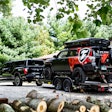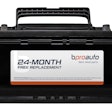The City of Oakland, Calif. was one of the first cities in the U.S. to switch its entire fleet to renewable diesel. The synthetic fuel took the place of biodiesel throughout the city’s fleet in late 2015.
Hard Working Trucks reached out recently to Oakland Interim Assistant Public Works Director Richard Battersby to find out how the fuel’s been performing. Battersby reported a significant drop in emissions, fewer DPF regens and cleanings, a shelf life comparable to conventional diesel and pricing also comparable and occasionally cheaper than conventional diesel.
HWT: How many diesel trucks are in Oakland’s fleet?
Battersby: We have 380 diesel-powered vehicles using renewable diesel from the Ford Super Duty V8 up to refuse trucks, street sweepers and fire apparatuses. We’ve got a lot of Cummins engines and Freightliner chassis. We even spec’d diesel-powered Chevrolet Cruze sedans for the fire department just so they can run them on this low carbon, lower emissions renewable biofuel. We use about 240,000 gallons of renewable diesel a year.
HWT: How many trucks are running on gasoline?
Battersby: We’ve got about 975 gasoline-powered vehicles. Most of those are police vehicles.
HWT: How long has it been since Oakland switched to renewable diesel?
Battersby: Just over two years (October 2015 started)
HWT: What are your overall impressions of the fuel?
Battersby: This is like some sort of a miracle alternative fuel: overnight emissions reductions (50 to 70 percent), chemically identical to diesel fuel, no vehicle or fuel storage modifications, mixes with all blends of petroleum and biodiesel, shelf life comparable to diesel and no increased NOx which are big negatives for biodiesel, 30 percent less PM emissions equals fewer DPF regens and cleanings, and all this at a price comparable and now trending ten cents per less than petroleum diesel.
HWT: How does it compare to conventional and biodiesel in terms of performance and maintenance-related issues?
Battersby: Similar to petroleum diesel, in fact indistinguishable from petroleum diesel as it is chemically identical. None of the traditional issues experienced with biodiesel such as short shelf life/instability, attacking fuel tank linings, plugged filters, accelerated microbial growth, etc.
HWT: Are all of your trucks running on RD? If not, what’s the percentage that are?
Battersby: Yes, 100 percent of our on- and off-road diesel vehicles including fire department apparatuses and emergency response vehicles are running on renewable as are diesel powered stationary generators in the city.
HWT: Any RD supply issues?
Battersby: None yet, but feedstock availability could make this an issue in the future for the lowest carbon intensity RD grade which is mandated for use in California (made from waste grease or animal fats). We now have multiple vendors offering the product. There are three RD refineries in the U.S. (all are currently expanding capacity) and another permitted for construction in Utah.
HWT: Approximate cost difference (percentage is fine) versus conventional diesel?
Battersby: Same price and trending cheaper.
HWT: Since RD burns cleaner, have oil change intervals been extended?
Battersby: We think this is true and just acquired an onsite oil analysis machine for our truck shop so we can verify and determine optimal oil change parameters.
HWT: Have emissions maintenance intervals changed at all?
Battersby: Yes, with 30 percent less PM emissions there is much less and there is much less material coming out of the engine into the DPF/PM traps so maintenance is greatly reduced. There is a great study done by the City of Knoxville on this very subject that I am attaching for you. This I predict will become the strongest selling point for RD in the future as it becomes more widely available.
HWT: What advice would you give to a fleet manager who’s thinking of trying RD?
Battersby: If the fuel is available in your area you should be running it in your fleet. There are already dozens and dozens of municipal fleets using it and big private corporations such as UPS and Google have been using this fuel for quite some time. If that isn’t good enough for you, run a demonstration and see for yourself. This a fuel that really the only thing you need to do to make the switch is pick up your phone and call a supplier to have a load of fuel delivered. It is literally that simple.










